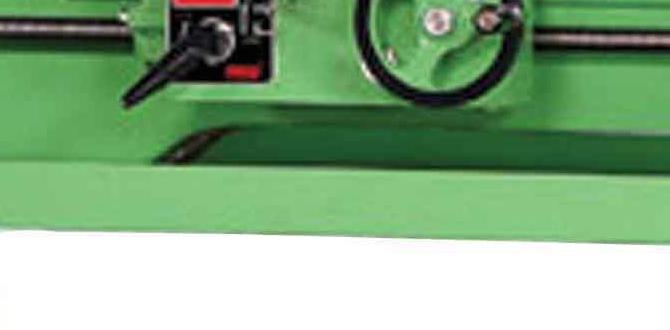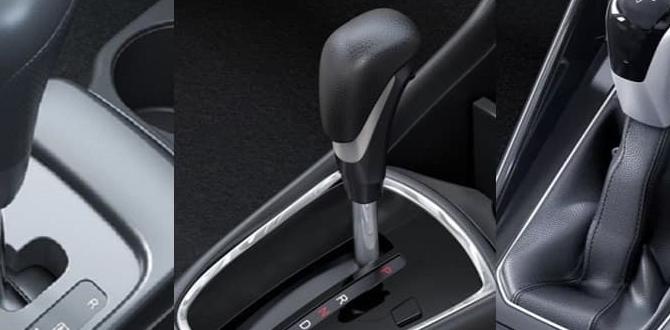Quick Summary: A 6-jaw chuck for your lathe is crucial for securely holding round, unusual, or precisely positioned workpieces. This guide breaks down why you need one, how to choose it, and the essential steps for using it safely and effectively on your lathe. Learn how to get the best results for your projects.
Hey there, fellow makers! Daniel Bates here from Lathe Hub. Ever found yourself wrestling with a workpiece that just won’t stay put on your lathe? Maybe it’s a tricky round shape, or you need super precise centering. That’s where a 6-jaw chuck comes in. It’s a workhorse for holding all sorts of materials, especially those odd shapes that a standard 3-jaw chuck struggles with. Don’t worry if it sounds complicated; we’re going to walk through everything you need to know, step-by-step, so you can master this essential tool.
Why a 6-Jaw Chuck is Your Lathe’s New Best Friend
When you’re starting out with a lathe, the 3-jaw chuck often does the heavy lifting for basic cylindrical pieces. But as your projects get more interesting, or when you need to hold something perfectly centered and without marring expensive material, the limitations of a 3-jaw chuck become clear. This is where the 6-jaw chuck shines, offering superior grip, better concentricity, and the ability to handle a wider variety of shapes.
The Magic of Six: Superior Grip and Precision
Think of it like this: six points of contact spread out evenly around your workpiece provide a much more stable and secure grip than just three. This is especially true for:
- Round Stock: While a 3-jaw chuck is designed for round stock, a 6-jaw chuck can often hold it with even less distortion, which is critical for thin-walled or delicate tubing. The pressure is distributed more evenly.
- Odd Shapes: If you’re working with hexagonal stock, large diameter tubing, or even irregularly shaped blanks, six jaws give you more options for achieving a solid grip.
- Precision Centering: For operations that require absolute accuracy, like turning long, thin shafts or drilling precise holes down the center of a large diameter, the 6-jaw chuck’s ability to fine-tune its grip is invaluable.
- Minimizing Deformation: For softer materials like brass, aluminum, or even wood, the six jaws distribute pressure, reducing the chance of crushing or deforming the workpiece, which is a common problem with 3-jaw chucks when significant force is applied.
When a 3-Jaw Chuck Falls Short
A 3-jaw chuck is fantastic for general-purpose work and is usually the standard on most beginner lathes. It’s quick and easy to use for round or hexagonal stock. However, when:
- Accuracy is paramount (think tenths of a thousandth of an inch).
- Working with thin-walled tubing that could be crushed.
- Holding non-standard shapes where finding three equally spaced grip points is difficult.
- You need to avoid marring highly polished surfaces.
…that’s when the superior capability of a 6-jaw chuck becomes not just desirable, but essential.
Types of 6-Jaw Chucks for Your Lathe
Just like 3-jaw chucks, 6-jaw chucks come in a few variations, mainly differing in how they are operated. The most common types you’ll encounter are:
1. Scroll Chucks (Self-Centering)
These are the most common type for both 3-jaw and 6-jaw configurations. They operate using a scroll plate, which is a spiral-shaped gear. When you turn the operating key, the scroll gear engages with the teeth on the back of the jaws, causing all six jaws to move in or out simultaneously and equally. This makes them “self-centering,” meaning they will find the center of the workpiece automatically.
- Pros: Fast to operate, automatically centers the workpiece, easy for beginners.
- Cons: Can have slightly less gripping force than manual chucks, accuracy can drift over time with wear.
2. Independent Jaw Chucks
Less common for 6-jaw configurations in hobbyist settings, but important to know about. With an independent jaw chuck, each jaw can be adjusted individually using its own screw. This allows for incredible precision in centering and also enables you to deliberately offset a workpiece if needed. Think of it as having six individual clamps that you can position precisely.
- Pros: Extremely precise, can hold square or rectangular stock by adjusting jaws individually, allows for intentional eccentric mounting.
- Cons: Much slower to operate, requires more skill to align and center accurately, typically more expensive.
3. Combination Chucks
Some chucks offer a combination of features, allowing for both self-centering (like a scroll chuck) and independent jaw adjustment. This provides the best of both worlds – the speed of self-centering for round stock and the precision adjustment for specialized tasks.
Choosing the Right Size and Mount
This is super important! A chuck that’s too big or too small won’t fit your lathe properly, or worse, can be dangerous. You need to know two things:
- Chuck Diameter: This is usually measured in inches (e.g., 6-inch, 8-inch, 10-inch). It should be appropriate for the swing (the maximum diameter of workpiece the lathe can handle) of your lathe. Consult your lathe’s manual.
- Spindle Mount Type: This is how the chuck physically attaches to the lathe’s spindle. Common types include:
- Threaded Mount (e.g., 1-8 UNC, 2-8 UNF): The back of the chuck has internal threads that screw onto the spindle nose. You need to match the thread size and pitch exactly.
- Camlock (D1-x): These have a specific standardized backplate design where hardened pins on the lathe spindle engage with locking cams on the chuck’s backplate. Common sizes are D1-4, D1-6, D1-8.
- A2 Mount: Similar to Camlock but a different design. Common sizes include A2-4, A2-5, A2-6, A2-8.
Tip: Always check your lathe’s manual for the exact spindle mount specifications. Using the wrong mount is impossible and dangerous.
Essential Components of a 6-Jaw Chuck
Let’s break down what makes up a typical scroll-type 6-jaw chuck, as this is what most beginners will encounter:
| Component | Description | Role |
|---|---|---|
| Body | The main housing of the chuck. Usually made of cast iron or steel. | Holds all the internal mechanisms and provides mounting points. |
| Jaws (6) | The gripping elements that move in and out. Often made of hardened steel. They can be “hard” (straight across) or “soft/” (can be machined to fit specific workpieces). | Directly grip and hold the workpiece. |
| Scroll Plate | A circular, spiral-grooved plate at the back of the chuck. | Engages with the jaw slides, translating rotational motion from the key into linear motion of the jaws. |
| Pinion Shafts (2 or 3) | These shafts have gears on them that mesh with the scroll plate. | Their rotation is driven by the chuck key inserted into sockets on their ends. |
| Chuck Key | A handle with a square end that fits into the pinion shafts. | Used to turn the pinion shafts, which in turn rotate the scroll plate and move the jaws. |
| Screw for Jaws | Some designs have screws that hold the individual jaws to their slides, allowing for replacement or machining. | Allows for jaw maintenance or customization. |
How to Mount a 6-Jaw Chuck Safely
Mounting a chuck is one of the most critical operations you’ll perform on a lathe. A poorly mounted chuck can fly off, causing serious injury and damage. Always follow these steps carefully.
Preparation is Key
Before you even touch the chuck:
- Cleanliness is Paramount: Ensure the lathe spindle threads (if applicable) and the chuck’s mounting surface are spotlessly clean. Any dirt, chips, or old grease can prevent a true fit and lead to imbalance or the chuck coming loose. Use a clean rag with a bit of solvent if necessary.
- Inspect Your Chuck: Check the chuck itself for any damage to the jaws, scroll, or mounting face.
- Know Your Mount: Double-check that you have the correct chuck for your lathe’s spindle nose (thread size and pitch, or Camlock/A2 size).
- Safety First: Make sure the lathe is OFF and the power is disconnected. Clear the area of unnecessary tools and debris.
Mounting Steps (Threaded Mount Example)
- Position the Chuck: Carefully lift the chuck and place it onto the spindle nose. If it’s heavy, use a hoist or get help. Align the threads by gently rotating the chuck counter-clockwise until you feel it “drop” slightly as the threads disengage, then rotate clockwise to engage the threads. This is called ‘chasing the threads’ and helps avoid cross-threading.
- Thread it On: Carefully screw the chuck onto the spindle by hand as far as it will go.
- Tighten with the Key: Insert the chuck key into the pinion shaft socket. Securely tighten the chuck against the spindle face. You’ll need to move the key around to all the pinion shafts to ensure the chuck is snug and seated correctly. The jaws should be closed (or nearly closed) during tightening to ensure the chuck is pulled up squarely.
- Check for Runout: Once mounted, you can power on the lathe and use an indicator to check for runout (wobble) on the chuck face or the inside diameter of the jaws. Minor adjustment might be possible by slightly loosening and re-tightening, but significant runout indicates a problem with mounting or the chuck itself.
Mounting Steps (Camlock or A2 Mount Example)
These mounts are generally more secure and easier to ensure alignment, but still require care.
- Align the chuck: Position the chuck so that the indexing pins on the spindle nose align with the designed slots or pockets on the chuck’s backplate.
- Seat the chuck: Push the chuck onto the spindle nose.
- Lock the cams: Insert the camlock wrench or chuck key into the cam levers on the front of the chuck. Turn each cam lever to lock the chuck firmly onto the spindle. Ensure all cams are fully engaged and tightened.
- Check for Runout: As with threaded chucks, use an indicator to check for runout.
External Resource: For a visual demonstration and more detail on safe chuck mounting, check out resources from manufacturers like:
Haas Automation’s tutorials on workpiece holding (While this link specifically mentions collet chucks, the principles of secure mounting are universal for lathe chucks on CNC machines and share similar safety considerations for manual lathes).
How to Use Your 6-Jaw Chuck to Hold Work
Now for the exciting part – putting that chuck to work! Using a 6-jaw chuck is similar to a 3-jaw, but with added benefits.
1. Opening and Closing the Jaws
For a scroll-type 6-jaw chuck:
- Locate the Key Sockets: You’ll see six sockets on the front of the chuck, corresponding to the pinion shafts.
- Insert the Key: Pick one socket. Insert the chuck key firmly.
- Turn to Open/Close: Turn the key clockwise to close the jaws and counter-clockwise to open them. For a 6-jaw scroll chuck, all jaws move together.
- Cycle Through Sockets: After a few turns in one socket, move the key to the next socket and continue turning in the same direction. You’ll need to cycle through all the pinion shafts (usually 2 or 3, depending on the chuck design) to get the full range of jaw movement.
Safety Note: Never leave a chuck key in the socket when the lathe is running!
2. Gripping Various Workpiece Types
This is where the 6-jaw chuck shines:
- Round Stock:
- Open the jaws wide enough to easily insert the stock.
- Place the stock into the chuck, ensuring it’s seated against the back of the chuck (if required by your operation).
- Close the jaws gently until they make contact.
- Cycle through the pinion shafts, tightening the jaws evenly. This distributes pressure and minimizes any ovaling of the workpiece.
- For critical accuracy, use a dial indicator to check for concentricity. You can sometimes make tiny adjustments to jaw seating by slightly loosening and re-tightening the jaws in sequence.
- Thin-Walled Tubing:
- Use soft jaws if you have them, and machine them to fit the inside diameter of the tube for maximum support.
- If using hard jaws, close them very gently. The 6 jaws distribute the clamping force so thinly that they are much less likely to crush the tube than a 3-jaw chuck.
- Consider using a steady rest for long, thin-walled pieces to provide additional support.
- Hexagonal or Octagonal Stock:
- A 6-jaw chuck is almost ideal for hexagonal stock. The jaws will naturally find points of contact on the flats.
- Ensure all six jaws are making firm contact. Close them just enough to grip securely, then cycle through the tightening process to ensure even pressure.
- Square Stock:
- This is where a 6-jaw chuck can be incredibly useful, especially a scroll type. You can often get a very good grip by closing the jaws onto the edges and corners.
- For extreme accuracy with square stock, an independent jaw chuck is best, or you may need to machine custom jaws. However, for many applications, a scroll 6-jaw will hold square stock adequately.
3. Centering and Alignment
The self-centering nature of a scroll 6-jaw chuck is its superpower. For basic round stock, closing the jaws usually gets you very close to perfect alignment.
If you need absolute precision, use a dial indicator:
- Mount the Indicator: Attach a dial indicator to your tool post or a magnetic base.
- Touch the Workpiece: With the lathe spinning slowly, bring the indicator’s probe into contact with the face or outer diameter of your workpiece.
- Read the Runout: Observe the indicator’s reading as the workpiece rotates. A reading of .001″ means it’s wobbling by one thousandth of an inch.
- Adjust (if necessary): If the runout is too high, you can try to adjust it. This usually involves slightly loosening the jaws on the side that is “high” and tightening the jaws on the opposite side. This is a delicate process and requires practice especially with scroll chucks. You might need to loosen all jaws, re-seat the workpiece, and then re-tighten.
Using 6 jaws often means less adjustment is needed compared to a 3-jaw because the initial seating is more stable. For truly critical alignment tasks that require repetitive holding of different pieces to the same exact center, consider using a specific set of machined soft jaws or an independent jaw chuck.
Maintaining Your 6-Jaw Chuck for Longevity
Like any precision tool, your 6-jaw chuck needs a little TLC to keep performing at its best.
Regular Cleaning
This is the most important thing you can do.
- After each use, brush out any metal chips or debris from the scroll grooves, jaw slides, and the chuck body.
- A blast of compressed air can help remove stubborn particles.
- Avoid washing with water, as this can lead to rust. If you must clean with a solvent, ensure the chuck is thoroughly dried and lubricated afterward.
Lubrication
Proper lubrication ensures smooth operation and prevents wear.
- Apply a light coating of spindle oil or a good




